Projected Characteristic Changes of a Typical Tropical Cyclone under Climate Change in the South West Indian Ocean
Abstract
:1. Introduction
2. Data and Methods
2.1. Cyclone Bejisa
2.2. Modeling Configuration
2.3. Construction of Future Environments
3. Results
3.1. Trajectory
3.2. Intensity
3.3. Rainfall
3.4. TC Size
3.5. Significant Wave Height
4. Summary and Conclusions
Author Contributions
Funding
Acknowledgments
Conflicts of Interest
Appendix A
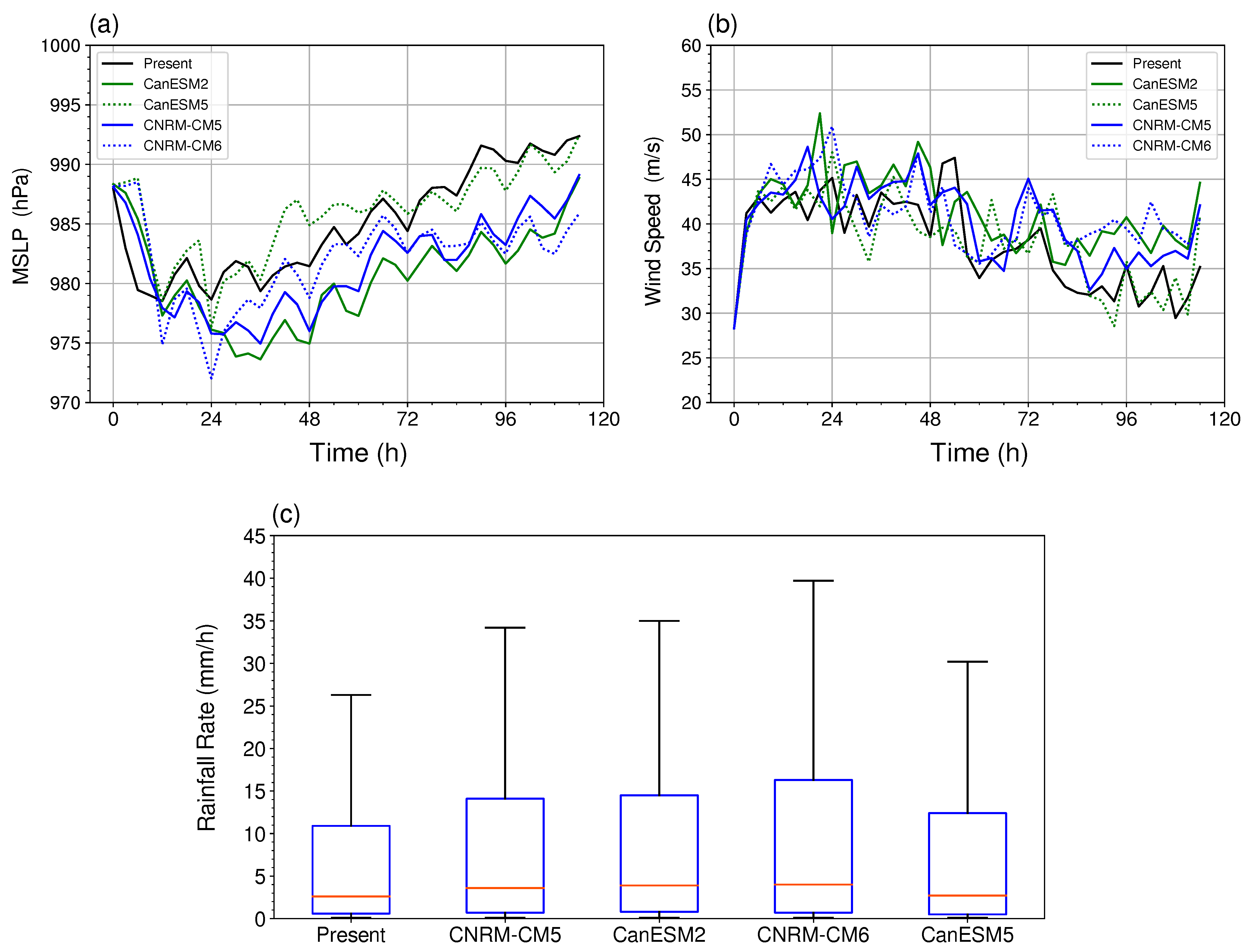
References
- Pianezze, J.; Barthe, C.; Bielli, S.; Tulet, P.; Jullien, S.; Cambon, G.; Bousquet, O.; Claeys, M.; Cordier, E. A New Coupled Ocean-Waves-Atmosphere Model Designed for Tropical Storm Studies: Example of Tropical Cyclone Bejisa (2013–2014) in the South-West Indian Ocean. J. Adv. Model. Earth Syst. 2018, 10, 801–825. [Google Scholar] [CrossRef] [Green Version]
- Kuleshov, Y.; Fawcett, R.; Qi, L.; Trewin, B.; Jones, D.; McBride, J.; Ramsay, H. Trends in tropical cyclones in the South Indian Ocean and the South Pacific Ocean. J. Geophys. Res. 2010, 115, D01101. [Google Scholar] [CrossRef]
- Holland, G.; Bruyère, C.L. Recent intense hurricane response to global climate change. Clim. Dyn. 2014, 42, 617–627. [Google Scholar] [CrossRef] [Green Version]
- Kossin, J.P.; Knapp, K.R.; Olander, T.L.; Velden, C.S. Global increase in major tropical cyclone exceedance probability over the past four decades. Proc. Natl. Acad. Sci. USA 2020. [Google Scholar] [CrossRef]
- Walsh, K.J.; McBride, J.L.; Klotzbach, P.J.; Balachandran, S.; Camargo, S.J.; Holland, G.; Knutson, T.; Kossin, J.P.; Lee, T.C.; Sobel, A.; et al. Tropical cyclones and climate change. Wiley Interdiscip. Rev. Clim. Change 2016, 7, 65–89. [Google Scholar] [CrossRef]
- Knutson, T.; Camargo, S.J.; Chan, J.C.L.; Emanuel, K.; Ho, C.H.; Kossin, J.; Mohapatra, M.; Satoh, M.; Sugi, M.; Walsh, K.; et al. Tropical Cyclones and Climate Change Assessment: Part II: Projected Response to Anthropogenic Warming. Bull. Am. Meteorol. Soc. 2020, 101, E303–E322. [Google Scholar] [CrossRef]
- Needham, H.F.; Keim, B.D.; Sathiaraj, D. A review of tropical cyclone-generated storm surges: Global data sources, observations, and impacts. Rev. Geophys. 2015, 53, 545–591. [Google Scholar] [CrossRef]
- Schär, C.; Frei, C.; Lüthi, D.; Davies, H.C. Surrogate climate-change scenarios for regional climate models. Geophys. Res. Lett. 1996, 23, 669–672. [Google Scholar] [CrossRef]
- Lackmann, G.M. Hurricane Sandy before 1900 and after 2100. Bull. Am. Meteorol. Soc. 2015, 96, 547–560. [Google Scholar] [CrossRef]
- Parker, C.L.; Bruyère, C.L.; Mooney, P.A.; Lynch, A.H. The response of land-falling tropical cyclone characteristics to projected climate change in northeast Australia. Clim. Dyn. 2018, 51, 3467–3485. [Google Scholar] [CrossRef]
- Mittal, R.; Tewari, M.; Radhakrishnan, C.; Ray, P.; Singh, T.; Nickerson, A.K. Response of tropical cyclone Phailin (2013) in the Bay of Bengal to climate perturbations. Clim. Dyn. 2019, 53, 2013–2030. [Google Scholar] [CrossRef]
- Emanuel, K.A. Downscaling CMIP5 climate models shows increased tropical cyclone activity over the 21st century. Proc. Natl. Acad. Sci. USA 2013, 110, 12219–12224. [Google Scholar] [CrossRef] [Green Version]
- Yamada, Y.; Satoh, M.; Sugi, M.; Kodama, C.; Noda, A.T.; Nakano, M.; Nasuno, T. Response of Tropical Cyclone Activity and Structure to Global Warming in a High-Resolution Global Nonhydrostatic Model. J. Clim. 2017, 30, 9703–9724. [Google Scholar] [CrossRef]
- Cattiaux, J.; Chauvin, F.; Bousquet, O.; Malardel, S.; Tsai, C.L. Projected changes in the southern Indian ocean cyclone activity assessed from high-resolution experiments and CMIP5 models. J. Clim. 2020. [Google Scholar] [CrossRef] [Green Version]
- Knutson, T.; McBride, J.L.; Chan, J.; Emanuel, K.; Holland, G.; Landsea, C.; Held, I.; Kossin, J.P.; Srivastava, A.K.; Sugi, M. Tropical cyclones and climate change. Nat. Geosci. 2010, 3, 157–163. [Google Scholar] [CrossRef] [Green Version]
- Global Guide. Global Guide to Tropical Cyclone Forecasting; World Meteorological Organization: Geneva, Switzerland, 2017; p. 397. [Google Scholar]
- Jumeaux, G.; Quetelard, H.; Roy, D. Atlas Climatique de La Réunion; La Documentation Française: Paris, France, 2011. [Google Scholar]
- Leroux, M.D.; Meister, J.; Mekies, D.; Dorla, A.L.; Caroff, P. A Climatology of Southwest Indian Ocean Tropical Systems: Their Number, Tracks, Impacts, Sizes, Empirical Maximum Potential Intensity, and Intensity Changes. J. Appl. Meteorol. Climatol. 2018, 57, 1021–1041. [Google Scholar] [CrossRef]
- Lac, C.; Chaboureau, J.P.; Masson, V.; Pinty, J.P.; Tulet, P.; Escobar, J.; Leriche, M.; Barthe, C.; Aouizerats, B.; Augros, C.; et al. Overview of the Meso-NH model version 5.4 and its applications. Geosci. Model Dev. 2018, 11, 1929–1969. [Google Scholar] [CrossRef] [Green Version]
- Caniaux, G.; Redelsperger, J.L.; Lafore, J.P. A Numerical Study of the Stratiform Region of a Fast-Moving Squall Line. Part I: General Description and Water and Heat Budgets. J. Atmos. Sci. 1994, 51, 2046–2074. [Google Scholar] [CrossRef] [Green Version]
- Pinty, J.P.; Jabouille, P. A mixed-phased cloud parameterization for use in a mesoscale non-hydrostatic model: Simulations of a squall line and of orographic precipitation. In Proceedings of the Conference on Cloud Physics, Everett, WA, USA, 17–21 August 1998. [Google Scholar]
- Lunet, T.; Lac, C.; Auguste, F.; Visentin, F.; Masson, V.; Escobar, J. Combination of WENO and Explicit Runge–Kutta Methods for Wind Transport in the Meso-NH Model. Mon. Weather Rev. 2017, 145, 3817–3838. [Google Scholar] [CrossRef]
- Bechtold, P.; Bazile, E.; Guichard, F.; Mascart, P.; Richard, E. A mass-flux convection scheme for regional and global models. Q. J. R. Meteorol. Soc. 2001, 127, 869–886. [Google Scholar] [CrossRef]
- Cuxart, J.; Bougeault, P.; Redelsperger, J.L. A turbulence scheme allowing for mesoscale and large-eddy simulations. Q. J. R. Meteorol. Soc. 2000, 126, 1–30. [Google Scholar] [CrossRef]
- Mlawer, E.J.; Taubman, S.J.; Brown, P.D.; Iacono, M.J.; Clough, S.A. Radiative transfer for inhomogeneous atmospheres: RRTM, a validated correlated-k model for the longwave. J. Geophys. Res. 1997, 102, 16663–16682. [Google Scholar] [CrossRef] [Green Version]
- Fouquart, Y.; Bonnel, B. Computations of Solar Heating of the Earth’s Atmosphere—A New Parameterization. Beitr. Phys. Atmos. 1980, 53, 35–62. [Google Scholar]
- Tolman, H.L. Effects of Numerics on the Physics in a Third-Generation Wind-Wave Model. J. Phys. Oceanogr. 1992, 22, 1095–1111. [Google Scholar] [CrossRef] [Green Version]
- Sherwood, S.C.; Ingram, W.; Tsushima, Y.; Satoh, M.; Roberts, M.; Vidale, P.L.; O’Gorman, P.A. Relative humidity changes in a warmer climate. J. Geophys. Res. Atmos. 2010, 115. [Google Scholar] [CrossRef] [Green Version]
- Taylor, K.E.; Stouffer, R.J.; Meehl, G.A. An Overview of CMIP5 and the experiment design. Bull. Am. Meteorol. Soc. 2012, 93, 485–498. [Google Scholar] [CrossRef] [Green Version]
- IPCC. Climate Change 2013: The Physical Science Basis. Contribution of Working Group I to the Fifth Assessment Report of the Intergovernmental Panel on Climate Change; Cambridge University Press: Cambridge, UK, 2013; p. 1535. [Google Scholar] [CrossRef] [Green Version]
- Donner, L.J.; Wyman, B.L.; Hemler, R.S.; Horowitz, L.W.; Ming, Y.; Zhao, M.; Golaz, J.C.; Ginoux, P.; Lin, S.J.; Schwarzkopf, M.D.; et al. The Dynamical Core, Physical Parameterizations, and Basic Simulation Characteristics of the Atmospheric Component AM3 of the GFDL Global Coupled Model CM3. J. Clim. 2011, 24, 3484–3519. [Google Scholar] [CrossRef]
- Giorgetta, M.A.; Jungclaus, J.; Reick, C.H.; Legutke, S.; Bader, J.; Böttinger, M.; Brovkin, V.; Crueger, T.; Esch, M.; Fieg, K.; et al. Climate and carbon cycle changes from 1850 to 2100 in MPI-ESM simulations for the Coupled Model Intercomparison Project phase 5. J. Adv. Model. Earth Syst. 2013, 5, 572–597. [Google Scholar] [CrossRef]
- Voldoire, A.; Sanchez-Gomez, E.; Salas y Melia, D.; Decharme, B.; Cassou, C.; Senesi, S.; Valcke, S.; Beau, I.; Alias, A.; Chevallier, M.; et al. The CNRM-CM5.1 global climate model: Description and basic evaluation. Clim. Dyn. 2013, 40, 2091–2121. [Google Scholar] [CrossRef] [Green Version]
- Yu, B.; Li, G.; Chen, S.; Lin, H. The role of internal variability in climate change projections of North American surface air temperature and temperature extremes in CanESM2 large ensemble simulations. Clim. Dyn. 2020, 55. [Google Scholar] [CrossRef]
- Collier, M.; Rotstayn, L.; Kim, K.Y.; Hirst, A.; Jeffrey, S. Ocean circulation response to anthropogenic-aerosol and greenhouse gas forcing in the CSIRO-Mk3.6 coupled climate model. Aust. Meteorol. Oceanogr. J. 2013, 63, 27–39. [Google Scholar] [CrossRef]
- Scoccimarro, E.; Gualdi, S.; Bellucci, A.; Sanna, A.; Fogli, P.G.; Manzini, E.; Vichi, M.; Oddo, P.; Navarra, A. Effects of Tropical Cyclones on Ocean Heat Transport in a High-Resolution Coupled General Circulation Model. J. Clim. 2011, 24, 4368–4384. [Google Scholar] [CrossRef] [Green Version]
- Gray, W.M. Global View of the Origin of Tropical Disturbances and Storms. Mon. Weather Rev. 1968, 96, 669–700. [Google Scholar] [CrossRef]
- Montgomery, M.T. Introduction to Hurricane Dynamics: Tropical Cyclone Intensification. In Advanced Numerical Modeling and Data Assimilation Techniques for Tropical Cyclone Predictions; Mohanty, U.C., Gopalakrishnan, S., Eds.; Springer: Berlin/Heidelberg, Germany, 2016; pp. 537–559. [Google Scholar] [CrossRef] [Green Version]
- Bister, M.; Emanuel, K.A. Dissipative heating and hurricane intensity. Meteorol. Atmos. Phys. 1998, 65, 1436–5065. [Google Scholar] [CrossRef]
- Kossin, J.P.; Emanuel, K.A.; Vecchi, G.A. The poleward migration of the location of tropical cyclone maximum intensity. Nature 2014, 1476–4687. [Google Scholar] [CrossRef] [PubMed] [Green Version]
- Patricola, C.M.; Wehner, M.F. Anthropogenic influences on major tropical cyclone events. Nature 2018, 563, 1476–4687. [Google Scholar] [CrossRef] [PubMed] [Green Version]
- Pohl, B.; Morel, B.; Barthe, C.; Bousquet, O. Regionalizing Rainfall at Very High Resolution over La Réunion Island: A Case Study for Tropical Cyclone Ando. Mon. Weather Rev. 2016, 144, 4081–4099. [Google Scholar] [CrossRef] [Green Version]
- Holland, G. WMO/TC-No. 560, Report No. TCP-31, World Meteorological Organization. 1993. Available online: https://wmo.asu.edu/content/world-greatest-twenty-four-hour-1-day-rainfall (accessed on 5 February 2021).
- Quetelard, H.; Bessemoulin, P.; Peterson, T.C.; Burton, A.; Boodhoo, Y.; Cerveny, R.S. WMO CCl Rapporteur for climate extremes decision, World Meteorological Organization. 2007. Available online: https://wmo.asu.edu/content/world-greatest-ninety-six-hour-4-day-rainfall (accessed on 5 February 2021).
- Wang, C.C.; Lin, B.X.; Chen, C.T.; Lo, S.H. Quantifying the Effects of Long-Term Climate Change on Tropical Cyclone Rainfall Using a Cloud-Resolving Model: Examples of Two Landfall Typhoons in Taiwan. J. Clim. 2015, 28, 66–85. [Google Scholar] [CrossRef]
- Gutmann, E.D.; Rasmussen, R.M.; Liu, C.; Ikeda, K.; Bruyere, C.L.; Done, J.M.; Garrè, L.; Friis-Hansen, P.; Veldore, V. Changes in Hurricanes from a 13-Yr Convection-Permitting Pseudo—Global Warming Simulation. J. Clim. 2018, 31, 3643–3657. [Google Scholar] [CrossRef]
- Allen, M.R.; Ingram, W.J. Constraints on future changes in climate and the hydrologic cycle. Nature 2002, 419, 1476–4687. [Google Scholar] [CrossRef]
- Pall, P.; Allen, M.R. Testing the Clausius–Clapeyron constraint on changes in extreme precipitation under CO2 warming. Clim. Dyn. 2007, 28, 351–363. [Google Scholar] [CrossRef]
- Knutson, T.; Sirutis, J.J.; Zhao, M.; Tuleya, R.E.; Bender, M.; Vecchi, G.A.; Villarini, G.; Chavas, D. Global Projections of Intense Tropical Cyclone Activity for the Late Twenty-First Century from Dynamical Downscaling of CMIP5/RCP4.5 Scenarios. J. Clim. 2015, 28, 7203–7224. [Google Scholar] [CrossRef] [Green Version]
- Napoli, A.; Crespi, A.; Ragone, F.; Maugeri, M.; Pasquero, C. Variability of orographic enhancement of precipitation in the Alpine regione. Sci. Rep. 2014, 9, 2045–2322. [Google Scholar] [CrossRef] [Green Version]
- Shi, X.; Durran, D.R. Estimating the Response of Extreme Precipitation over Midlatitude Mountains to Global Warming. J. Clim. 2015, 28, 4246–4262. [Google Scholar] [CrossRef] [Green Version]
- Siler, N.; Roe, G. How will orographic precipitation respond to surface warming? An idealized thermodynamic perspective. Geophys. Res. Lett. 2014, 41, 2606–2613. [Google Scholar] [CrossRef]
- Sun, Y.; Zhong, Z.; Li, T.; Yi, L.; Hu, Y.; Wan, H.; Chen, H.; Liao, Q.; Ma, C.; Li, Q. Impact of Ocean Warming on Tropical Cyclone Size and Its Destructiveness. Sci. Rep. 2017, 7, 8154. [Google Scholar] [CrossRef] [PubMed]
- Hill, K.A.; Lackmann, G.M. Influence of Environmental Humidity on Tropical Cyclone Size. Mon. Weather Rev. 2009, 137, 3294–3315. [Google Scholar] [CrossRef]
- Lynn, B.H.; Healy, R.; Druyan, L.M. Investigation of Hurricane Katrina characteristics for future, warmer climates. Clim. Res. 2009, 39, 75–86. [Google Scholar] [CrossRef]
- Kim, H.S.; Vecchi, G.A.; Knutson, T.; Anderson, W.G.; Delworth, T.L.; Rosati, A.; Zeng, F.; Zhao, M. Tropical Cyclone Simulation and Response to CO2 Doubling in the GFDL CM2.5 High-Resolution Coupled Climate Model. J. Clim. 2014, 27, 8034–8054. [Google Scholar] [CrossRef]
- Lin, N.; Emanuel, K.; Oppenheimer, M.; Vanmarcke, E. Physically based assessment of hurricane surge threat under climate change. Nat. Clim. Chang. 2012, 2, 462–467. [Google Scholar] [CrossRef] [Green Version]
- Chen, J.; Wang, Z.; Tam, C.Y.; Lau, N.C.; Lau, D.S.D.; Mok, H.Y. Impacts of climate change on tropical cyclones and induced storm surges in the Pearl River Delta region using pseudo-global-warming method. Sci. Rep. 2020, 10, 1965. [Google Scholar] [CrossRef] [Green Version]
- Cai, W.; Yang, K.; Wu, L.; Huang, G.; Santoso, A.; Ng, B.; Wang, G.; Yamagata, T. Opposite response of strong and moderate positive Indian Ocean Dipole to global warming. Nat. Clim. Chang. 2021, 11, 27–32. [Google Scholar] [CrossRef]
- Tsai, C.L.; Bousquet, O.; Malardel, S.; Cattiaux, J.; Chauvin, F. Impact of Globe Warming on Tropical Depression Characteristics in Southwest Indian Ocean Investigating by High-resolution ARPGEG Simulations. Atmosphere 2020. submitted. [Google Scholar]


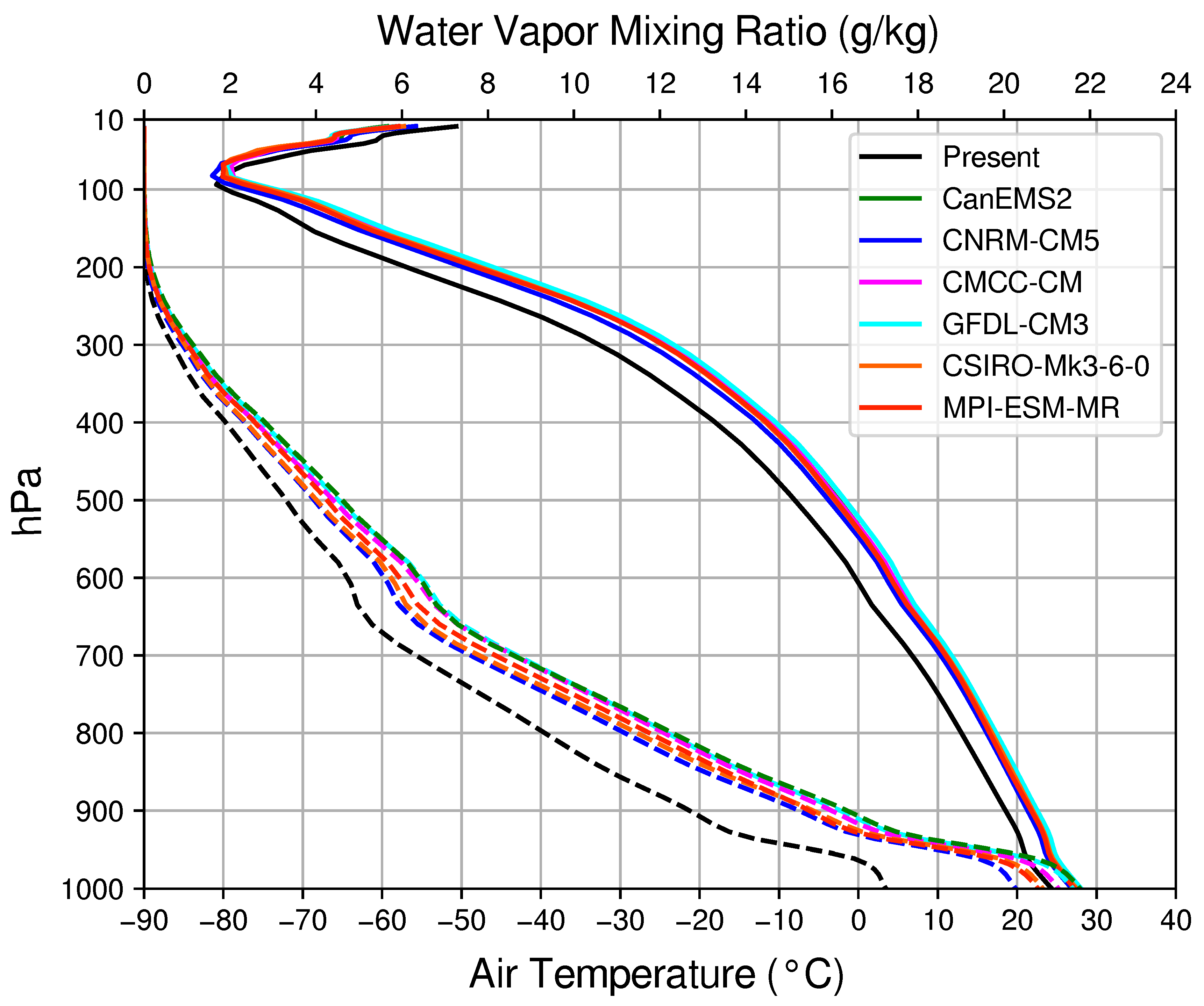



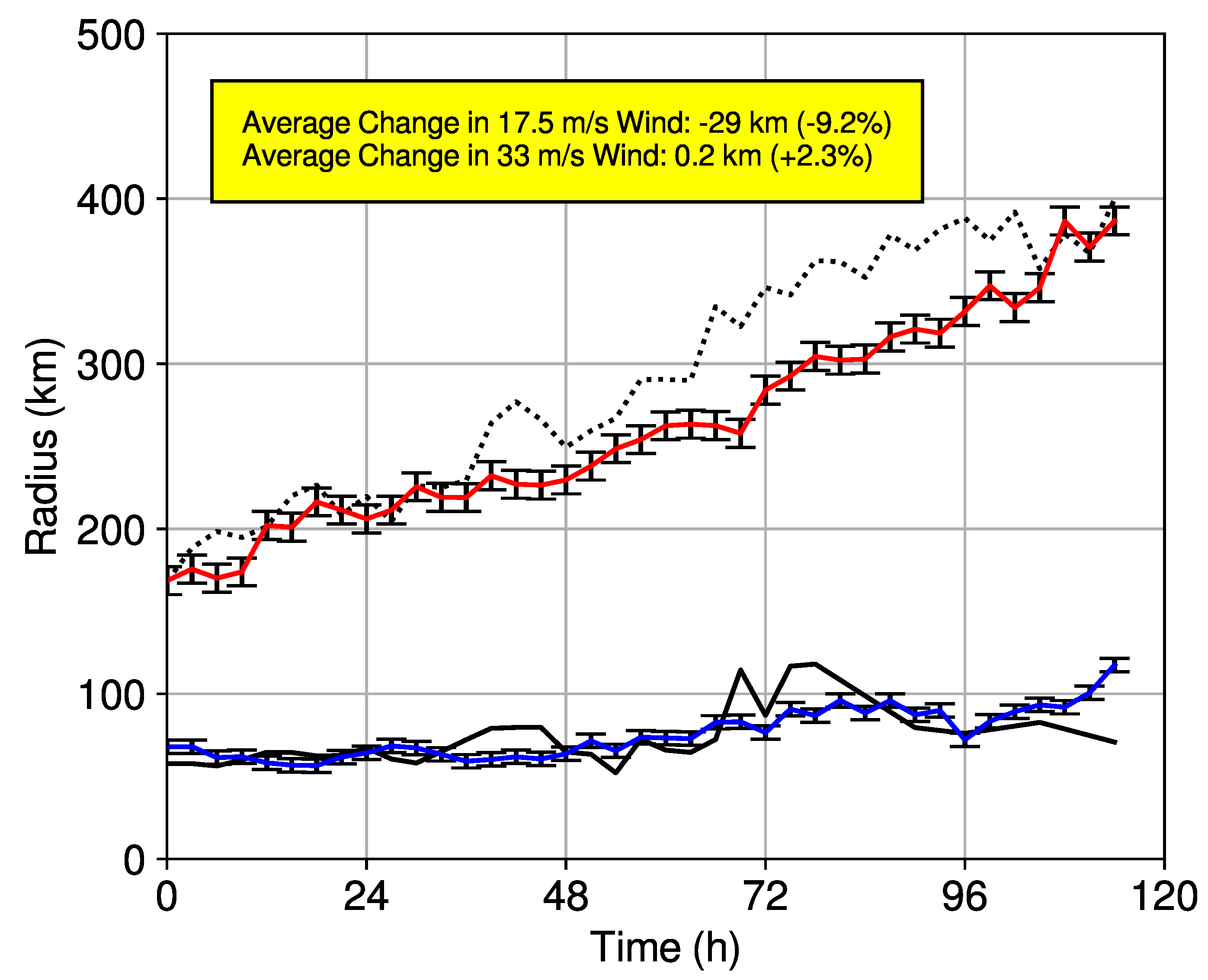
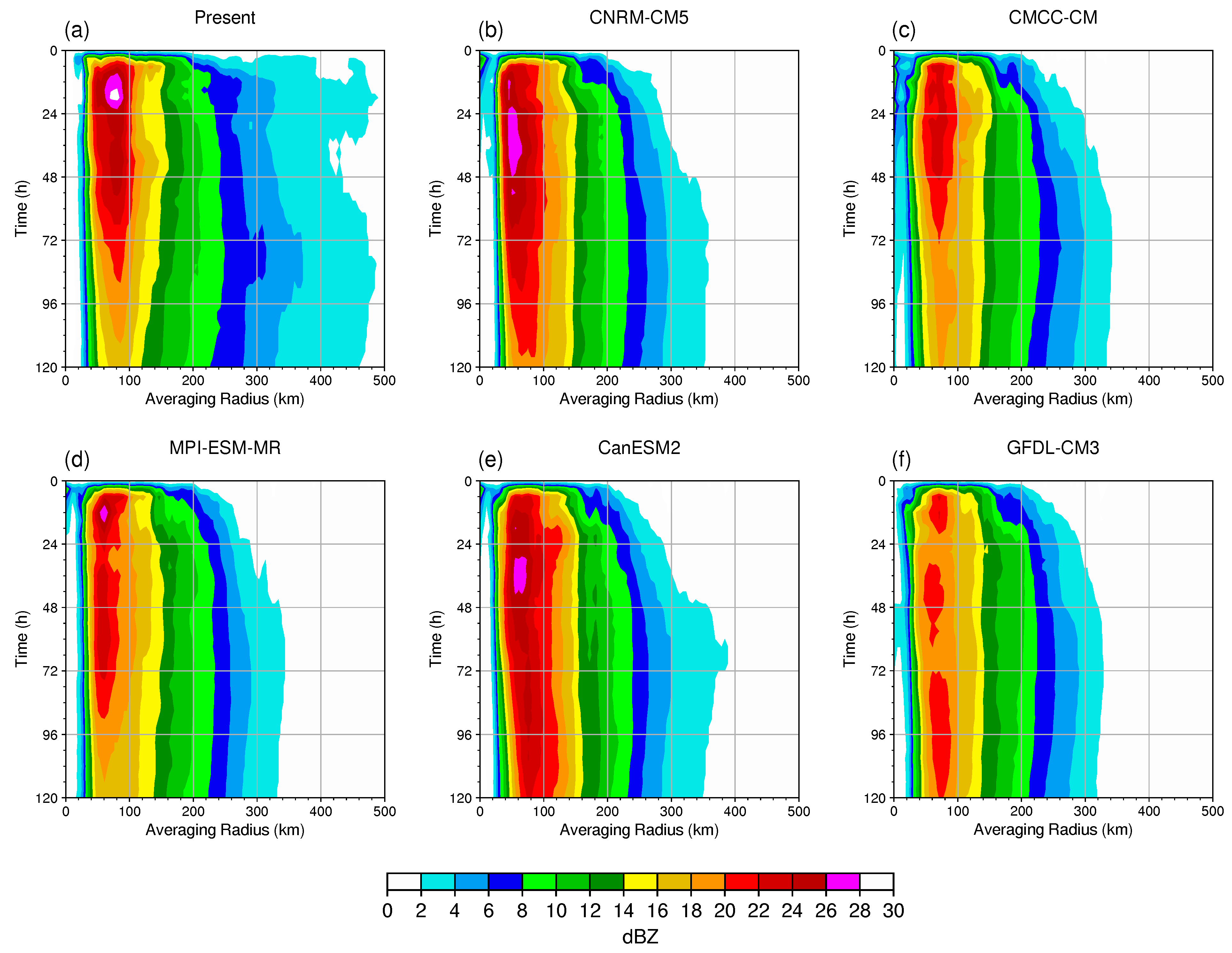
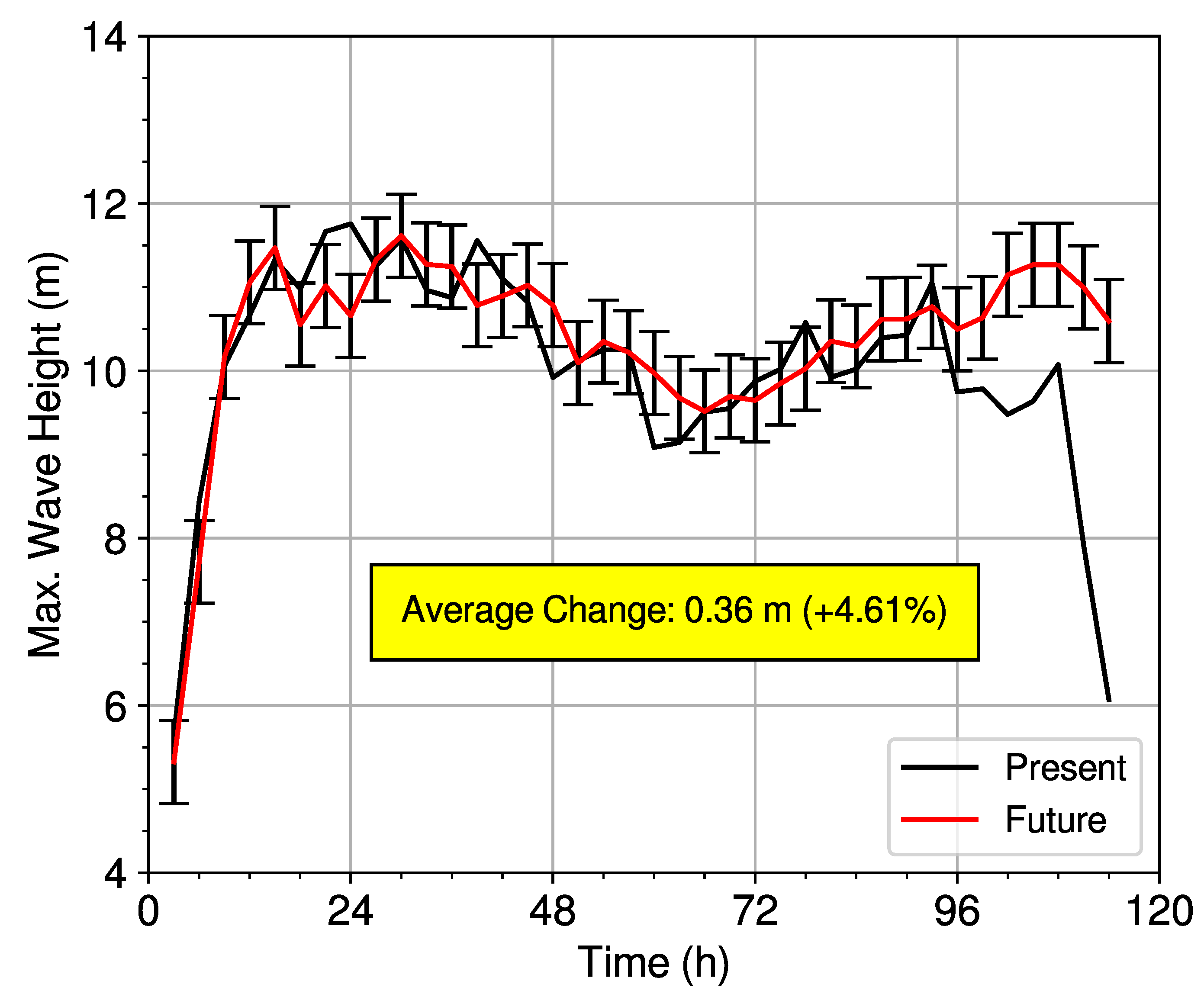

| Model | Full Name | Horizontal Resolution (Lat × Lon) | Number of Vertical Levels |
|---|---|---|---|
| CanESM2 | Canadian Earth System Model, version 2 | 2.8 × 2.8 | 35 |
| CanESM5 | Canadian Earth System Model, version 5 | 2.8 × 2.8 | 49 |
| MPI-ESM-MR | Max Planck Institute Earth System Model Medium Resolution | 1.9 × 1.9 | 95 |
| CMCC-CM | Centro Euro-Mediterraneo sui Cambiamenti Climatici Climate Model | 0.75 × 0.75 | 31 |
| CSIRO-Mk3-6-0 | Commonwealth Scientific and Industrial Research Organisation Mark, version 3.6.0 | 1.9 × 1.9 | 18 |
| GFDL-CM3 | Geophysical Fluid Dynamics Laboratory Climate Model, version 3 | 2 × 2.5 | 48 |
| CNRM-CM5 | Centre National de Recherches Météorologiques Coupled Global Climate Model, version 5 | 1.4 × 1.4 | 31 |
| CNRM-CM6 | Centre National de Recherches Météorologiques Coupled Global Climate Model, version 6 | 1.4 × 1.4 | 91 |
| Scenario | Maximum Potential Intensity | Lifetime Maximum Intensity | Latitude of LMI |
|---|---|---|---|
| Present | 924 | 979 | –16.3 |
| CMCC-CM | 920 | 974 | –19.9 |
| CanESM2 | 919 | 979 | –17.9 |
| MPI-ESM-MR | 905 | 975 | –19.8 |
| GFDL-CM3 | 894 | 978 | –18.1 |
| CNRM-CM5 | 890 | 978 | –16.1 |
| Surface Wind Speed | Median Rain Rate | 90th Percentile Rain Rate | Radius of 17.5 m/s Wind | Radius of 33 m/s Wind | Significant Wave Height | |
|---|---|---|---|---|---|---|
| CNRM-CM5 | 7.00 | 38.46 | 23.11 | −7.08 | 4.73 | 8.39 |
| CanESM2 | 9.39 | 49.99 | 27.3 | −5.28 | 10.00 | 11.87 |
| CMCC-CM | 4.87 | 23.08 | 31.06 | −11.90 | 1.31 | 0.27 |
| MPI-ESM-MR | 6.32 | 23.08 | 32.92 | −11.26 | −6.28 | 2.89 |
| GFDL-CM3 | 5.17 | 34.62 | 28.79 | −10.51 | 1.84 | −0.34 |
| Multi-Model Average | 6.55 (±1.62) | 33.85 (±10.14) | 28.64 (±3.36) | −9.21 (±2.57) | 2.32 (±5.29) | 4.61 (±4.76) |
Publisher’s Note: MDPI stays neutral with regard to jurisdictional claims in published maps and institutional affiliations. |
© 2021 by the authors. Licensee MDPI, Basel, Switzerland. This article is an open access article distributed under the terms and conditions of the Creative Commons Attribution (CC BY) license (http://creativecommons.org/licenses/by/4.0/).
Share and Cite
Thompson, C.; Barthe, C.; Bielli, S.; Tulet, P.; Pianezze, J. Projected Characteristic Changes of a Typical Tropical Cyclone under Climate Change in the South West Indian Ocean. Atmosphere 2021, 12, 232. https://doi.org/10.3390/atmos12020232
Thompson C, Barthe C, Bielli S, Tulet P, Pianezze J. Projected Characteristic Changes of a Typical Tropical Cyclone under Climate Change in the South West Indian Ocean. Atmosphere. 2021; 12(2):232. https://doi.org/10.3390/atmos12020232
Chicago/Turabian StyleThompson, Callum, Christelle Barthe, Soline Bielli, Pierre Tulet, and Joris Pianezze. 2021. "Projected Characteristic Changes of a Typical Tropical Cyclone under Climate Change in the South West Indian Ocean" Atmosphere 12, no. 2: 232. https://doi.org/10.3390/atmos12020232






